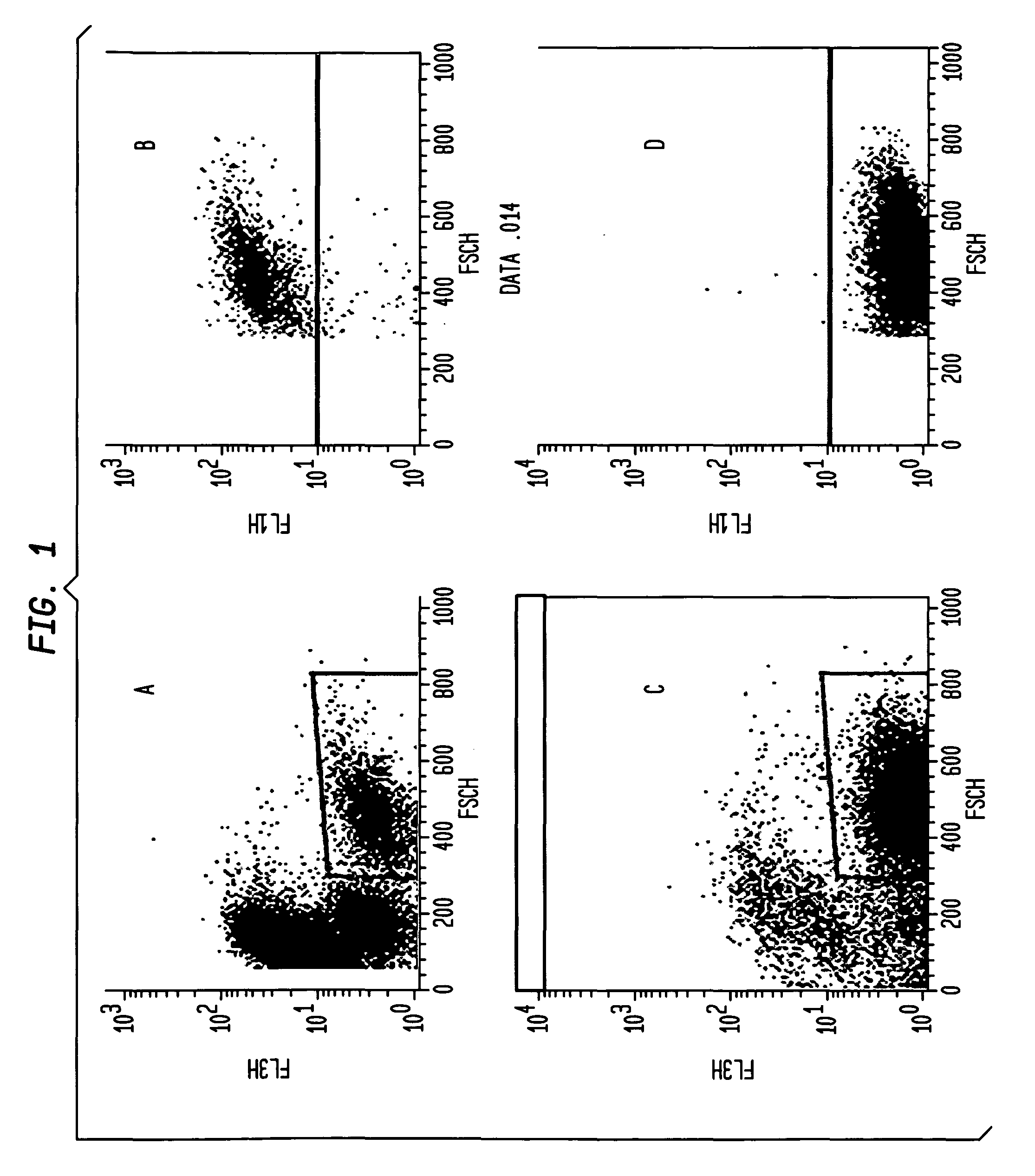Assay for identifying antigens that activate b cell receptors comprising neutralizing antibodies
a technology of neutralizing antibodies and antibodies, which is applied in the field of antibody detection of antigens that activate b cell receptors, can solve the problems of reducing the efficacy cell death, and cell death, and the absence of igd reduces the effect of b cell participation in immune responses
- Summary
- Abstract
- Description
- Claims
- Application Information
AI Technical Summary
Benefits of technology
Problems solved by technology
Method used
Image
Examples
example 1
Flexstation Ca++ Influx Assay in DT40
[0200]A Ca++ influx assay used to measure primary signal strength in both DT40 cells and human peripheral mature naïve B cells is robust and sensitive. The Molecular Devices Calcium 3, 4, and 5 Assays are currently among the most suitable for high-throughput analysis. Roach et al. demonstrated that the assay is highly sensitive in culture splenic B cells from human bcl-2 transgenic mice (Roach et al. 2004. AfCS Research Reports 2 (13 BC)); Ca++ signaling assays have also been performed in DT40 cells (Yasuda & Yamamoto, 2001. In: Methods in Molecular Biology, vol. 271: B Cell Protocols, Eds Gu H and Rajewsky K. Humana Press Inc., Totowa, N.J.); we tested Ca++ influx in DT40 cells with the Molecular Devices Calcium 4 Assay kits or reagents.
[0201]Wild-type DT40 cells expressing surface-bound IgM, and AID− / − / IgH− / IgL− cells described by Arakawa et al. (Arakawa, Hauschild, & Buerstedde, 2002. Science 295:1301-6) were cultured in RPMI (Invitrogen) with...
example 2
Expression of “Chickenized” Surface IgM in DT40 Cells
[0205]In order to screen potential HIV immunogens for their effect on B cell signaling DT40 cell lines expressing broadly neutralizing anti-HIV antibodies as surface-bound IgM are generate. We modified the human broadly neutralizing anti-HIV antibody, B 12 (SEQ ID NO 1, SEQ ID NO 3, SEQ ID NO 3, and SEQ ID NO 4) by replacing the IgG1 heavy chain C terminus with the C-terminus of chicken IgM, including the membrane anchor domain. The result is a gene that directs expression of a chimeric membrane-bound heavy chain that, co-expressed with the light chain, has b12 specificity, and that functions as part of the chicken DT40 BCR complex. This allows evaluation of B cell responses following HIV antigen binding. To ensure that observed responses result from activation of BCR complexes comprising surface-expressed anti-HIV Ab H & L chains, AID− / − / IgH− / IgL− DT40 cells were used for expression and Ca++ assays.
[0206]WT DT40 cells were grown ...
example 3
NFκB-Responsive Induction of Reporter Gene Assay
[0208]DT40 cells are transfected both with a vector driving expression of the b12 broadly neutralizing anti-HIV Env surface IgM, and with a vector reporting cRel / NFκB-responsive expression of the luciferase reporter gene (FIG. 4; SEQ ID NO 12). Doubly transfected cells are isolated by dual marker selection (GFP and RFP), and seeded in 96-well plates, as described above. In the presence and absence of CD40 ligand and T helper cytokines, cells are stimulated with the positive control, anti-IgM, to cross-link the BCR, and the max-strength signal downstream of BCR activation is generated. The luciferase signals are read on a plate-reader between 24 and 48 hours following stimulation.
[0209]Using the HIV immunogens YU2, JRFL, and DU422 as examples (SEQ ID NO 9, SEQ ID NO 10, and SEQ ID NO 11, respectively), each antibody in human peripheral mature naïve B cells is assayed at various concentrations for dose response curves. Cells are stimulat...
PUM
| Property | Measurement | Unit |
|---|---|---|
| pH | aaaaa | aaaaa |
| pH | aaaaa | aaaaa |
| total volume | aaaaa | aaaaa |
Abstract
Description
Claims
Application Information
 Login to View More
Login to View More - R&D
- Intellectual Property
- Life Sciences
- Materials
- Tech Scout
- Unparalleled Data Quality
- Higher Quality Content
- 60% Fewer Hallucinations
Browse by: Latest US Patents, China's latest patents, Technical Efficacy Thesaurus, Application Domain, Technology Topic, Popular Technical Reports.
© 2025 PatSnap. All rights reserved.Legal|Privacy policy|Modern Slavery Act Transparency Statement|Sitemap|About US| Contact US: help@patsnap.com



